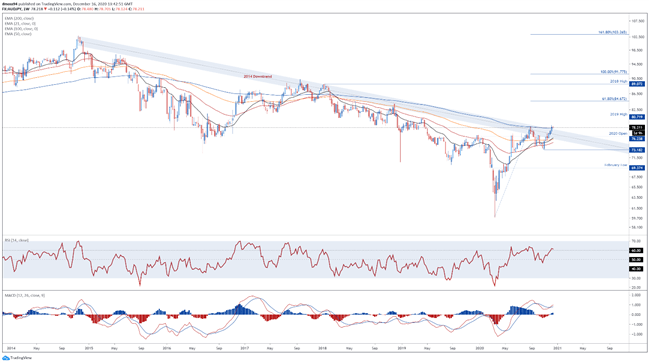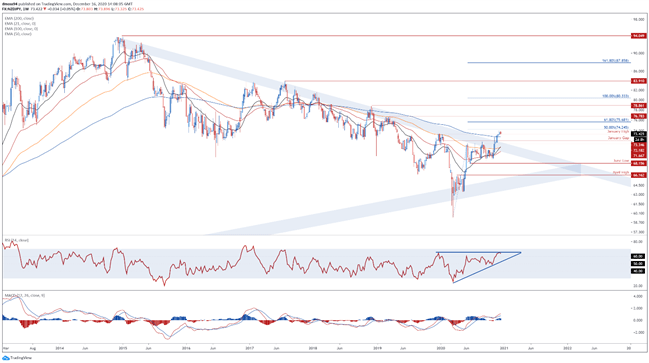JPY Technical Forecast: Bearish
- AUD/JPY poised to extend recent gains after slicing through the 200-day moving average.
- NZD/JPY eyeing push to multi-year highs after clearing long-term trend resistance.
Coming Soon! Download the NEW 1st Quarter Forecast Live on Monday on our Free Trading Guides Page !
The haven-associated Japanese Yen has lost significant ground against the cyclically-sensitive Australian and New Zealand Dollars, falling over 31% and 24% respectively since topping at the height of the coronavirus crash in March. These losses look set to extend into the first quarter of 2021 as both exchange rates breach key long-term resistance.
AUD/JPY Weekly Chart – Break Above 200-MA Hints at Further Gains

AUD/JPY weekly chart created using TradingView
The AUD/JPY exchange rate seems poised to extend its recent surge from its lowest levels since early 2009, as prices break back above the sentiment-defining 200-week moving average (78.07) for the first time since 2018, and breach the downtrend extending from the 2014 high.
With the RSI holding constructively above 60, and the MACD tracking firmly above its neutral midpoint, the path of least resistance looks to favor the upside.
A weekly close above psychological resistance at 79.00 would probably signal the resumption of the primary uptrend and bring the 2019 high (80.71) into focus. Clearing that likely opens the door for buyers to begin probing the 61.8% Fibonacci expansion (84.67).
Conversely, sliding back below the 200-MA could trigger a short-term pullback towards the December low (76.90), with a weekly close below carving a path for price to challenge confluent support at the 21-MA (75.59) and former resistance-turned-support at the 2014 downtrend.
NZD/JPY Weekly Chart – Snapping 2014 Downtrend May Trigger Topside Push

NZD/JPY weekly chart created using TradingView
The longer-term outlook for NZD/JPY rates also seems skewed to the topside, as prices break above the psychologically imposing 73.00 mark and slice through the 200-MA (72.93) for the first time since December 2018.
However, bearish RSI divergence hints at fading bullish momentum and suggests that NZD/JPY could be at risk of a short-term pullback, if sellers successfully hurdle support at the December low (72.96).
That being said, with the MACD indicator storming to its highest levels since July 2017 and price tracking firmly above all four moving averages, the path of least resistance seems to lead higher.
A weekly close above the 50% Fibonacci (74.25) would probably neutralize near-term selling pressure and carve a path for prices to challenge the 2019 high (76.78). Breaching that likely propels NZD/JPY towards key resistance at the 100% Fibonacci (80.33).
Alternatively, a weekly close back below the 200-MA may allow sellers to regain control of the exchange rate and drive prices back to key support at the June high (71.67). A convincing break below may invalidate bullish potential and bring the 100-MA (71.10) into the crosshairs.
-- Written by Daniel Moss, Analyst for DailyFX
Follow me on Twitter @DanielGMoss









